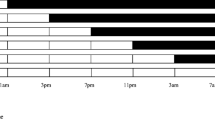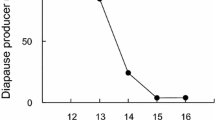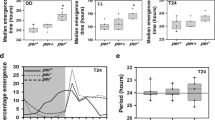Abstract
Numerous insect species living in temperate regions survive adverse conditions, such as winter, in a state of developmental arrest. The most reliable cue for anticipating seasonal changes is the day-to-night ratio, the photoperiod. The molecular mechanism of the photoperiodic timer in insects is mostly unclear. Multiple pieces of evidence suggest the involvement of circadian clock genes, however, their role might be independent of their well-established role in the daily oscillation of the circadian clock. Furthermore, reproductive diapause is preferentially studied in females, whereas males are usually used for circadian clock research. Given the idiosyncrasies of male and female physiology, we decided to test male reproductive diapause in a strongly photoperiodic species, the linden bug Pyrrhocoris apterus. The data indicate that reproduction is not under circadian control, whereas the photoperiod strongly determines males’ mating capacity. Clock mutants in pigment dispersing factor and cryptochrome-m genes are reproductive even in short photoperiod. Thus, we provide additional evidence of the participation of circadian clock genes in the photoperiodic time measurement in insects.




Similar content being viewed by others
Data availability
All data are available in the manuscript and supplementary materials.
References
Bajgar A, Jindra M, Dolezel D (2013a) Autonomous regulation of the insect gut by circadian genes acting downstream of juvenile hormone signaling. Proc Natl Acad Sci USA 110:4416–4421. https://doi.org/10.1073/pnas.1217060110
Bajgar A, Dolezel D, Hodkova M (2013b) Endocrine regulation of non-circadian behavior of circadian genes in insect gut. J Insect Physiol 59:881–886. https://doi.org/10.1016/j.jinsphys.2013.06.004
Bradshaw WE, Holzapfel CM (2010) What season is it anyway? Circadian tracking vs. photoperiodic anticipation in insects. J Biol Rhythms 25:155–165. https://doi.org/10.1177/0748730410365656
Chang DC, McWatters HG, Williams JA et al (2003) Constructing a feedback loop with circadian clock molecules from the silkmoth, Antheraea pernyi. J Biol Chem 278:38149–38158. https://doi.org/10.1074/jbc.M306937200
Cyran SA, Buchsbaum AM, Reddy KL et al (2003) vrille, Pdp1, and dClock form a second feedback loop in the Drosophila circadian clock. Cell 112:329–341. https://doi.org/10.1016/s0092-8674(03)00074-6
Denlinger DL, Yocum GD, Rinehart JP (2012) Hormonal control of diapause. In: Gilbert LI (ed) insect endocrinology. Academic Press, San Diego, pp 430–463. https://doi.org/10.1016/B978-0-12-384749-2.10010-X
Dolezel D (2015) Photoperiodic time measurement in insects. Curr Opin Insect Sci 7:98–103. https://doi.org/10.1016/j.cois.2014.12.002
Dolezel D (2023) Molecular mechanism of the circadian clock. In: Numata H, Tomioka K (eds) Insect chronobiology, 1st edn. Springer, Singapore
Dolezel D, Vanecková H, Sauman I, Hodkova M (2005) Is period gene causally involved in the photoperiodic regulation of reproductive diapause in the linden bug, Pyrrhocoris apterus? J Insect Physiol 51:655–659. https://doi.org/10.1016/j.jinsphys.2005.01.009
Dolezel D, Sauman I, Koštál V, Hodkova M (2007) Photoperiodic and food signals control expression pattern of the clock gene, period, in the linden bug, Pyrrhocoris apterus. J Biol Rhythms 22:335–342. https://doi.org/10.1177/0748730407303624
Dolezel D, Zdechovanova L, Sauman I, Hodkova M (2008) Endocrine-dependent expression of circadian clock genes in insects. Cell Mol Life Sci 65:964–969. https://doi.org/10.1007/s00018-008-7506-7
Dolezelova E, Dolezel D, Hall JC (2007) Rhythm defects caused by newly engineered null mutations in Drosophila's cryptochrome gene. Genet 177(1):329–345. https://doi.org/10.1534/genetics.107.076513
Emery P, Stanewsky R, Helfrich-Förster C et al (2000) Drosophila CRY Is a Deep Brain Circadian Photoreceptor. Neuron 26(2):493–504. https://doi.org/10.1016/S0896-6273(00)81181-2
Goto SG (2022) Photoperiodic time measurement, photoreception, and circadian clocks in insect photoperiodism. Appl Entomol Zool 57:193–212. https://doi.org/10.1007/s13355-022-00785-7
Hall JC (2003) Genetics and molecular biology of rhythms in Drosophila and other insects. Genet Circad Rhy 48:1–280. https://doi.org/10.1016/s0065-2660(03)48000-0
Hardin PE (2011) Chapter 5—molecular genetic analysis of circadian timekeeping in Drosophila. In: Brody S (ed) Advances in genetics. Academic Press, Hoboken, pp 141–173. https://doi.org/10.1016/B978-0-12-387690-4.00005-2
Hejníková M, Nouzova M, Ramirez CE et al (2022) Sexual dimorphism of diapause regulation in the hemipteran bug Pyrrhocoris apterus. Insect Biochem Mol Biol 142:103721. https://doi.org/10.1016/j.ibmb.2022.103721
Hodek I (1971) Termination of adult diapause in Pyrrhocoris apterus (Heteroptera: Pyrrhocoridae) in field. Entomol Exp Appl 14:212–222. https://doi.org/10.1111/j.1570-7458.1971.tb00158.x
Hodková M, Syrová Z, Dolezel D, Šauman I (2003) Period gene expression in relation to seasonality and circadian rhythms in the linden bug, Pyrrhocoris apterus (Heteroptera). Eur J Entomol 100:267–273. https://doi.org/10.14411/eje.2003.042
Hughes ME, Hogenesch JB, Kornacker K (2010) JTK_CYCLE: an efficient nonparametric algorithm for detecting rhythmic components in genome-scale data sets. J Biol Rhythms 25(5):372–380. https://doi.org/10.1177/0748730410379711
Ikeno T, Tanaka SI, Numata H, Goto SG (2010) Photoperiodic diapause under the control of circadian clock genes in an insect. BMC Biol 8:116. https://doi.org/10.1186/1741-7007-8-116
Ikeno T, Katagiri C, Numata H, Goto SG (2011a) Causal involvement of mammalian-type cryptochrome in the circadian cuticle deposition rhythm in the bean bug Riptortus pedestris. Insect Mol Biol 20:409–415. https://doi.org/10.1111/j.1365-2583.2011.01075.x
Ikeno T, Numata H, Goto SG (2011b) Photoperiodic response requires mammalian-type cryptochrome in the bean bug Riptortus pedestris. Biochem Biophys Res Commun 410:394–397. https://doi.org/10.1016/j.bbrc.2011.05.142
Ikeno T, Numata H, Goto SG (2011c) Circadian clock genes period and cycle regulate photoperiodic diapause in the bean bug Riptortus pedestris males. J Insect Physiol 57:935–938. https://doi.org/10.1016/j.jinsphys.2011.04.006
Ikeno T, Ishikawa K, Numata H, Goto SG (2013) Circadian clock gene Clock is involved in the photoperiodic response of the bean bug Riptortus pedestris. Physiol Entomol 38:157–162. https://doi.org/10.1111/phen.12013
Jaumouillé E, Machado Almeida P, Stähli P et al (2015) Transcriptional regulation via nuclear receptor crosstalk required for the Drosophila circadian clock. Curr Biol 25:1502–1508. https://doi.org/10.1016/j.cub.2015.04.017
Kaniewska MM, Vaněčková H, Doležel D, Kotwica-Rolinska J (2020) Light and temperature synchronizes locomotor activity in the linden bug, Pyrrhocoris apterus. Front Physiol 11:242. https://doi.org/10.3389/fphys.2020.00242
Kostál V, Tollarová M, Dolezel D (2008) Dynamism in physiology and gene transcription during reproductive diapause in a heteropteran bug, Pyrrhocoris apterus. J Insect Physiol 54:77–88. https://doi.org/10.1016/j.jinsphys.2007.08.004
Koštál V (2011) Insect photoperiodic calendar and circadian clock: independence, cooperation, or unity? J Insect Physiol 57:538–556. https://doi.org/10.1016/j.jinsphys.2010.10.006
Kotwica-Rolinska J, Pivarciova L, Vaneckova H, Dolezel D (2017) The role of circadian clock genes in the photoperiodic timer of the linden bug Pyrrhocoris apterus during the nymphal stage. Physiol Entomol 42:266–273. https://doi.org/10.1111/phen.12197
Kotwica-Rolinska J, Chodakova L, Chvalova D et al (2019) CRISPR/Cas9 genome editing introduction and optimization in the non-model insect Pyrrhocoris apterus. Front Physiol 10:891. https://doi.org/10.3389/fphys.2019.00891
Kotwica-Rolinska J, Chodáková L, Smýkal V et al (2022a) Loss of timeless underlies an evolutionary transition within the circadian clock. Mol Biol Evol 39:1. https://doi.org/10.1093/molbev/msab346
Kotwica-Rolinska J, Damulewicz M, Chodakova L et al (2022b) Pigment Dispersing Factor is a circadian clock output and regulates photoperiodic response in the linden bug, Pyrrhocoris apterus. Front Physiol 13:884–909. https://doi.org/10.3389/fphys.2022.884909
Netušil R, Tomanová K, Chodáková L et al (2021) Cryptochrome-dependent magnetoreception in a heteropteran insect continues even after 24 h in darkness. J Exp Biol 224(19):jeb243000. https://doi.org/10.1242/jeb.243000
Numata H, Saulich HA, Volkovich AT (1993) Photoperiodic responses of the linden bug, Pyrrhocoris apterus, under conditions of constant temperature and under thermoperiodic conditions. Zool Sci 10:521–527
Ozkaya O, Rosato E (2012) The circadian clock of the fly: a neurogenetics journey through time. Adv Genet 77:79–123. https://doi.org/10.1016/B978-0-12-387687-4.00004-0
Peschel N, Helfrich-Förster C (2011) Setting the clock—by nature: circadian rhythm in the fruitfly Drosophila melanogaster. FEBS Lett 585:1435–1442. https://doi.org/10.1016/j.febslet.2011.02.028
Pivarciova L, Vaneckova H, Provaznik J et al (2016) Unexpected geographic variability of the free running period in the linden bug Pyrrhocoris apterus. J Biol Rhythms 31:568–576. https://doi.org/10.1177/0748730416671213
Renn SC, Park JH, Rosbash M et al (1999) A pdf neuropeptide gene mutation and ablation of PDF neurons each cause severe abnormalities of behavioral circadian rhythms in Drosophila. Cell 99:791–802. https://doi.org/10.1016/s0092-8674(00)81676-1
Saunders DS (1983) A diapause induction-termination asymmetry in the photoperiodic responses of the linden bug, Pyrrhocoris apterus and an effect of near-critical photoperiods on development. J Insect Physiol 29:399–405. https://doi.org/10.1016/0022-1910(83)90067-7
Schmid B, Helfrich-Förster C, Yoshii T (2011) A new ImageJ plug-in “ActogramJ” for chronobiological analyses. J Biol Rhythms 26:464–467. https://doi.org/10.1177/0748730411414264
Smykal V, Bajgar A, Provazník J et al (2014) Juvenile hormone signaling during reproduction and development of the linden bug, Pyrrhocoris apterus. Insect Biochem Mol Biol 45:69–76. https://doi.org/10.1016/j.ibmb.2013.12.003
Socha R (1993) Pyrrhocoris apterus (Heteroptera)—an experimental model species: a review. Eur J Entomol 90:241–286
Socha R (2010) Pre-diapause mating and overwintering of fertilized adult females: new aspects of the life cycle of the wing-polymorphic bug Pyrrhocoris apterus (Heteroptera: Pyrrhocoridae). Eur J Entomol 107:521–525. https://doi.org/10.14411/eje.2010.059
Stanewsky R, Kaneko M, Emery P et al (1998) The cryb mutation identifies cryptochrome as a circadian photoreceptor in Drosophila. Cell 95(5):681–692. https://doi.org/10.1016/S0092-8674(00)81638-4
Thakkar N, Giesecke A, Bazalova O et al (2022) Evolution of casein kinase 1 and functional analysis of new doubletime mutants in Drosophila. Front Physiol 13:1062632. https://doi.org/10.3389/fphys.2022.1062632
Tokuoka A, Itoh TQ, Hori S et al (2017) cryptochrome genes form an oscillatory loop independent of the per/tim loop in the circadian clockwork of the cricket Gryllus bimaculatus. Zool Lett 3:5. https://doi.org/10.1186/s40851-017-0066-7
Tomioka K (2014) Chronobiology of crickets: a review. Zool Sci 31:624–632. https://doi.org/10.2108/zs140024
Tomioka K, Matsumoto A (2015) Circadian molecular clockworks in non-model insects. Curr Opin Insect Sci 7:58–64. https://doi.org/10.1016/j.cois.2014.12.006
Urbanová V, Bazalová O, Vaněčková H, Dolezel D (2016) Photoperiod regulates growth of male accessory glands through juvenile hormone signaling in the linden bug, Pyrrhocoris apterus. Insect Biochem Mol Biol 70:184–190. https://doi.org/10.1016/j.ibmb.2016.01.003
Werckenthin A, Huber J, Arnold T et al (2020) Neither per, nor tim1, nor cry2 alone are essential components of the molecular circadian clockwork in the Madeira cockroach. PLoS ONE 15:1–26. https://doi.org/10.1371/journal.pone.0235930
Yuan Q, Metterville D, Briscoe AD, Reppert SM (2007) Insect cryptochromes: gene duplication and loss define diverse ways to construct insect circadian clocks. Mol Biol Evol 24:948–955. https://doi.org/10.1093/molbev/msm011
Zhang Y, Markert MJ, Groves SC et al (2017) Vertebrate-like CRYPTOCHROME 2 from monarch regulates circadian transcription via independent repression of CLOCK and BMAL1 activity. Proc Natl Acad Sci USA 114:E7516–E7525. https://doi.org/10.1073/pnas.1702014114
Acknowledgements
We thank Hana Vaněčková for technical support, and all current laboratory members for the excellent working atmosphere.
Funding
This work was supported by European Research Council (ERC) under the European Union’s Horizon 2020 Program Grant Agreement 726049 to DD. MMK has received funding from the European Union’s Horizon 2020 research and innovation programme under the Marie Sklodowska-Curie grant agreement No. 765937 (CINCHRON).
Author information
Authors and Affiliations
Contributions
MMK and DD designed the experiments. MMK performed the experiments, analyzed data, and drew the figures with input from DD. MMK and DD interpreted the data and wrote the manuscript.
Corresponding author
Ethics declarations
Conflict of interest
The authors declare no conflict of interest.
Additional information
Publisher's Note
Springer Nature remains neutral with regard to jurisdictional claims in published maps and institutional affiliations.
Handling Editor: Charlotte Helfrich-Förster.
Supplementary Information
Below is the link to the electronic supplementary material.
Rights and permissions
Springer Nature or its licensor (e.g. a society or other partner) holds exclusive rights to this article under a publishing agreement with the author(s) or other rightsholder(s); author self-archiving of the accepted manuscript version of this article is solely governed by the terms of such publishing agreement and applicable law.
About this article
Cite this article
Kaniewska, M.M., Chvalová, D. & Dolezel, D. Impact of photoperiod and functional clock on male diapause in cryptochrome and pdf mutants in the linden bug Pyrrhocoris apterus. J Comp Physiol A (2023). https://doi.org/10.1007/s00359-023-01647-5
Received:
Revised:
Accepted:
Published:
DOI: https://doi.org/10.1007/s00359-023-01647-5




